Crossroads Vol.2
■いろはにほへと―日本語(ことば)と邦楽器―
作曲家 高橋久美子 × 声楽家 青山恵子
Crossroads Vol.2
Kumiko Takahashi meets Keiko Aoyama
- Japanese Songs with Japanese Instruments –
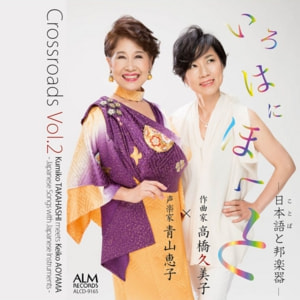 ALCD-9165 税込価格¥2,750(税抜価格¥2,500) 2017/01/07発売 JAN 4530835 111474青山恵子(メゾソプラノ)
ALCD-9165 税込価格¥2,750(税抜価格¥2,500) 2017/01/07発売 JAN 4530835 111474青山恵子(メゾソプラノ)
石川 高(笙)
首藤久美子(琵琶)
てん・仁智(てん じんち):(箏)
本條秀慈郎(三味線)
松尾慧(篠笛)
山本亜美(二十五絃箏)
音楽現代 推薦盤
高橋久美子:
[1] しだれざくら―紫の上―
[2] 邦楽落語「愛宕山」
-声と二十五絃箏のための- 北原白秋 抒情小曲集『思ひ出』より
[3] 水ヒアシンス
[4] 朝
[5] 歌ひ時計
[6] 花いかだ
[7] いろはにほへと
青山恵子(メゾソプラノ)
石川 高(笙) [6]
首藤久美子(琵琶) [1]
てん・仁智(てん じんち) (箏)[6]
本條秀慈郎(三味線) [2]
松尾慧(篠笛) [1]
山本亜美(二十五絃箏) [3]-[5]
〈録音〉相模湖交流センター 2016年8月9-10日、9月27日
邦楽曲において、必ずその楽器を所有し習得してから創るというスタイルをとり、西洋音楽を母体とする自身の音楽に邦楽の要素を深いレベルで取り込み、時間と空間を超越する独特の音楽を作り出す作曲家、高橋久美子。日本歌曲の唱法を日本の伝統音楽の側から研究し尽くし、日本語の発音、発声に人生を賭ける青山恵子。この二人のコラボレーションによる、ほかにはない世界観。これぞまさしく、現代の、新しい伝統音楽!
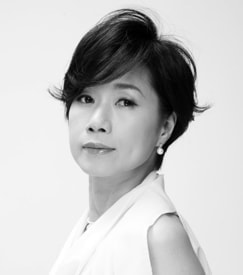 (C) Koshu Endo高橋久美子(たかはし くみこ):作曲・編曲家
(C) Koshu Endo高橋久美子(たかはし くみこ):作曲・編曲家
武蔵野音楽大学音楽教育学科卒業。ピアノ専攻。クラシックはもとより邦楽、舞台、映像音楽等ジャンルを超えた作曲活動を国内外で行っている。また邦楽曲においては、必ずその楽器を所有し習得してから創るというスタイルをとっている。これまでに箏、三味線、尺八、琵琶、篳篥、笙、能管、大・小鼓、そして謡等を学ぶ。楽譜は邦楽譜と五線譜の両方で多数公刊されている。2015年より邦洋の枠を超え各分野のスペシャリストと新たな世界を創生していくシリーズ「Crossroads」CDをリリース。第一弾は箏曲家 野坂操壽氏とのコラボレーションによる「箏曲を繋ぐ」。作曲を田辺恒弥氏に師事。作曲家グループ<邦楽2010>代表、日本音楽集団団員。
http://www.geocities.jp/ktittj/
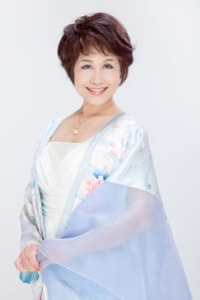 (C) Koshu Endo青山恵子(あおやま けいこ):メゾ・ソプラノ
(C) Koshu Endo青山恵子(あおやま けいこ):メゾ・ソプラノ
東京芸術大学及び大学院博士課程修了。1987年声楽では日本初の博士号を、テーマ「日本歌曲の実践的研究〜伝統音楽との接点〜」で取得。その後も洋楽と伝統音楽の歌唱法の融合を研究し、邦楽器伴奏の作品や語り物、モノオペラなど様々なスタイルの作品に取り組んでいる。近年、「古事記」「奥の細道」「万葉集」や、小泉八雲の作品などを素材にした新作によるコンサートを積極的に催している。オペラでは東京室内歌劇場「浅茅が宿」「星の王子さま」。2008年新国立劇場「黒船」お松役などに出演。2011年2月にニューヨークにおける“ミュージック・フロム・ジャパン”音楽祭に初の声楽家として招かれた。1975年四家文子主宰・波の会「第一回日本歌曲コンクール」第1位、1998年ミュージックペンクラブ「コンサートパフォーマンス賞」。東京室内歌劇場会員。波の会日本歌曲振興会名誉会員。
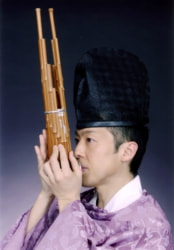 石川 高(いしかわ こう): 笙
石川 高(いしかわ こう): 笙
1990年より笙の演奏活動をはじめ、国内、世界中の音楽祭に出演してきた。雅楽団体「伶楽舎(れいがくしゃ)」に所属し、雅楽古典曲や現代作品を数多く演奏している。笙の独奏者としても、様々な音楽家、作曲家と共に、新たな音楽の次元を開拓してきた。催馬楽など雅楽の歌唱でも高い評価を受けている。和光大学、学習院大学、沖縄県立芸術大学、九州大学にて講義を行っている。
http://radiant-osc.com/
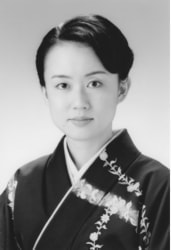 首藤久美子(しゅとう くみこ):琵琶
首藤久美子(しゅとう くみこ):琵琶
東京音楽大学卒業。薩摩琵琶を田中之雄氏に師事。NHK邦楽技能者育成会43期首席修了。第39回日本琵琶楽コンクール第1位、文部科学大臣賞・日本放送協会賞受賞。岩城宏之指揮・相模原室内合奏団、京都市交響楽団、円光寺雅彦指揮・神奈川フィルハーモニー管弦楽団、大野和士指揮・BBC交響楽団、バルセロナ交響楽団、アイヴィン・グルベルグ=イェンセン指揮・リヨン国立管弦楽団、広上淳一指揮・京都市交響楽団、マルコ・イヴァノヴィチ指揮・プラハ放送交響楽団による武満徹「ノヴェンバー・ステップス」を三橋貴風氏(尺八)と演奏。NHK「邦楽のひととき」「芸能花舞台」、国立劇場主催公演出演。海外公演多数。
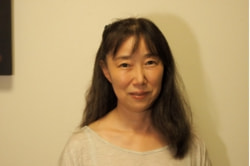 てん・仁智(てん じんち):箏
てん・仁智(てん じんち):箏
東京藝術大学卒業後、どの流派にも、どの音楽ジャンルにも属さない姿勢で60回以上に及ぶ自作自演のソロ・コンサートを日本各地で開催。楽箏用の絹絃が発するその音楽の独自性は「伝統のくびきからこれほど自由に、その核心の部分を生かすことができる演奏家は貴重である」と高く評価される。一方、即興により、ツトム・ヤマシタ(打楽器)、三宅榛名(作曲・ピアノ)、武久源造(鍵盤楽器)、大倉正之助(大鼓)、直川礼緒(口琴)等、個性的な演奏家とも共演。現在は、八橋流(生田流・山田流の先行箏曲)について江戸時代の文献を基に調査・研究中。CDは「刻の記憶Ⅱ」「箏の古典と白繭の響き」他多数。映画・テレビ等の映像音楽も多数担当。
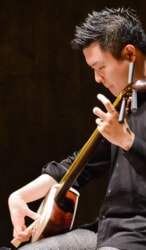 本條秀慈郎(ほんじょう ひでじろう):三味線
本條秀慈郎(ほんじょう ひでじろう):三味線
栃木県宇都宮市出身。本條流家元本條秀太郎師に古典、現代音楽を師事し本條秀慈郎の名を許される。津軽三味線を長谷川裕翔氏に師事、桐朋学園大学短期大学部入学し故杵屋勝芳壽氏に師事。現代邦楽研究所修了。Acc Nakamura kimpeiフェローシップに選出されNYへ留学。演出家、故蜷川幸雄氏に“繊細で、時に強く烈しいその演奏は深い感動を呼び起こす”と評される。くまもと全国邦楽コンクール最優秀賞。文部科学大臣賞。“花筐 高田和子氏へのオマージュ”を開催し文化庁芸術祭新人賞。出光音楽賞。宇都宮エスペール賞。東京オペラシティ財団B→C選出。新しい作品の委嘱活動等、次の三味線音楽を創造している。4回のリサイタルを開催。Acc Nakamura kimpeiフェローシップに選出されNYへ留学。桐朋学園芸術短期大学非常勤講師。本名鮎沢京吾。
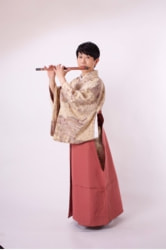 松尾慧(まつお けい):篠笛
松尾慧(まつお けい):篠笛
日本の伝統的横笛(篠笛、能菅、龍笛、神楽笛など)を演奏、現代邦楽の合奏や、雅楽、民俗芸能の演奏のほか、ソロ、様々なアンサンブルの形で活動している。箏、三絃、琵琶などの邦楽器とのアンサンブルにとどまらず、多様な洋楽器、民族楽器とのセッション、舞踊とのコラボレーションにも取り組んでいる。能管を能楽森田流松田弘之氏に、龍笛、高麗笛、神楽笛を伶楽舎宮丸直子氏に師事。篠笛は、仲林光子氏に手ほどきを受け、竹井誠、鯉沼廣行、村山二朗各氏に、古典、現代曲、民俗芸能の笛を学ぶ。
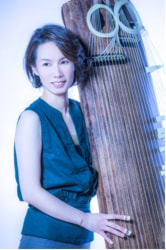 山本亜美(やまもと つぐみ):二十五絃箏
山本亜美(やまもと つぐみ):二十五絃箏
箏演奏家。NHK邦楽技能者育成会第39期修了。文化庁新進芸術家国内研修制度研修生として、一年間、二十五絃箏を野坂操壽師のもとで学ぶ。この楽器の表現の広さに魅了され、その後おもに二十五絃箏奏者として活動。国際交流基金主催公演による海外公演や、同基金PAJプログラムにより米•仏のピアニストデュオと箏、そして映像との企画「Strings & Serpents」を北米ツアーなどにて展開中。また、国内においても現代作品の新作初演や即興、録音などで活動。二十五絃箏ソロアルバム「つむぐ- Spinning The Thread-」をリリース。高橋久美子、森亜紀、田口和行各氏の作品や自作品を収録。
Kumiko Takahashi:
[1] Shidare-zakura (The Weeping Cherry Blossoms)
[2] Hogaku Rakugo “Atago-yama”
–For Voice and twenty-five string koto– from the Hakushu Kitahara lyric pieces “Omoide (Memories)”
[3] Water Hyacinth
[4] Morning
[5] Singing Clock
[6] Hana Ikada (Flower Raft)
[7] I RO HA NI HO HE TO
Keiko AOYAMA, mezzo-soprano
Ko ISHIKAWA, sho [6]
Kumiko SHUTO, biwa [1]
Ten Jinchi, so (koto) [6]
HONJOH Hidejiro, shamisen [2]
Kei MATSUO, shinobue [1]
Tsugumi YAMAMOTO, twenty-five string koto [3]-[5]
Recording Location: Sagamiko Koryu Center, 9-10 August & 27 September 2016
Kumiko TAKAHASHI composer & arranger
Graduate of the music education department of Musashino Academia Musicae with a piano major, Kumiko Takahashi actively composes not only in the classical genre, but for traditional Japanese music, theater and film in Japan and overseas. She has studied composition under Tsuneya Tanabe. When it comes to writing for traditional Japanese instruments, she has a distinct style of familiarizing herself with and learning how to play the instrument before writing for it. So far she has learned the koto, shamisen, shakuhachi, biwa, hichriki, sho, noh flute, large and small tsuzumi and noh singing. In 2015, Kumiko launched a CD series that crosses musical boundaries, creating a new musical realm by working with artists from both Western and Japanese musical genres. The first was a collaboration with koto performer Soju Nosaka, titled “Kumiko Takahashi meets Soju Nosaka: New Compositions for Koto”. She is the artistic director of the Hōgaku Composers Alliance, and member of the Pro Musica Nipponia.
http://www.geocities.jp/ktittj/
Keiko AOYAMA mezzo-soprano
Keiko Aoyama graduated from the Tokyo University of the Arts in 1987, and was the first vocalist to receive a doctorate in Japan. Her thesis was titled “Practical Research on Vocal Techniques Used in Japanese Art Song - The Applicability of Traditional Japanese Vocal Genres -”. After graduating, Keiko continued to investigate how to marry the Western classical singing tradition with Japanese traditional singing techniques, and has performed an extensive range of compositions, including works with song and narration accompanied by traditional Japanese instruments and mono operas.
In recent years, Keiko has been holding concerts showcasing new works based on ancient and classical Japanese texts such as “Kojiki”, Matsuo Basho’s “Oku no Hosomichi (Narrow Road)”, “Manyoshu” and works by Yakumo Koizumi. Some of the operatic works she performed during this time include “Asajigayado” and “The Little Prince”, performed by the Tokyo Chamber Opera Theater.
In 2008 she was in Kosaku Yamada’s opera “Black Ships” as Omatsu at the New National Theater Tokyo, and in February 2011 she was the first vocalist to be invited to the music festival “Music from Japan” held in New York.
Keiko received 1st prize at the First Japanese Song Competition held by Fumiko Yotsuya and NAMI NO KAI in 1975, and the Concert Performance Prize from the Music Pen Club in 1998.
She is currently a member of the Tokyo Chamber Opera Theater, and an honorary member of NAMI NO KAI Nihon Kakyoku Association.
Ko ISHIKAWA sho
Ko Ishikawa began his career as a sho player in 1990, and has since performed in music festivals all over Japan and across the globe. He is a member of the gagaku organization Reigakusha, where he has performed many traditional and contemporary compositions, and has also established his own musical realm as a solo performer with various musicians and composers. Ko is also highly acclaimed for his singing in the gagaku tradition, such as saibara (folk songs arranged for gagaku).
As an educator, Ko has been teaching at Wako University, Gakushuin University, Okinawa Prefectural University of Arts and Kyushu University.
http://radiant-osc.com/
Kumiko SHUTO biwa
Kumiko Shuto graduated from Tokyo College of Music, and studied Satsuma-biwa
under Yukio Tanaka. She completed the NHK Hogaku Training Program at the top of the 43rd class, and has received 1st prize at the 39th Japanese Biwa Music Competition, the Ministry of Education Award for Fine Arts and the NHK Award at the 39th National Biwa Music Competition in Japan.
She has performed with many orchestras including the Sagamihara Chamber Orchestra and the Kyoto City Symphony Orchestra conducted by Hiroyuki Iwaki, the Kanagawa Philharmonic Orchestra conducted by Masahiko Enkoji, the BBC Symphony Orchestra and the Barcelona Symphony Orchestra conducted by Kazushi Ono, Orchestre National de Lyon conducted by Eivind Gullberg Jensen, the Kyoto Symphony Orchestra conducted by Junichi Hirokami, and performed Toru Takemitsu’s “November Steps” with Kifu Mitsuhashi and the Prague Radio Symphony Orchestra, conducted by Marko Ivanovic.
She has also performed in concerts produced by the National Theater of Japan, as well as media appearances including “Hogaku no Hitotoki” on NHK national radio and “Geino Hana Butai”, an NHK television program showcasing young upcoming artists in the traditional Japanese music scene. Kumiko performs in many concerts overseas as well as performing regularly in Japan.
Ten Jinchi so (koto)
Since graduating from Tokyo University of Fine Arts, Ten Jinchi has performed in over 60 self-produced concerts all over Japan, establishing herself as an artist who is not bound to any particular musical style or genre. Her unique musical style that is emitted from the silk strings of the so (koto) has been highly acclaimed and she has been described as “a truly valuable artist who has broken free of the typical restraints of tradition, but is still capable of utilizing the essential core of the tradition to the fullest in her music.”
Meanwhile, she has also performed improvisation with such distinctive musicians as Stomu Yamash’ta (percussion), Haruna Miyake (composition, piano), Genzoh Takehisa (keyboard instruments), Shonosuke Okura (otsuzumi) and Leo Tadagawa (Jew’s harp). Currently, she is researching Yatsuhashi-ryu (the style of koto which precedes the current two main styles of koto, Ikuta-ryu and Yamada-ryu), by studying literature from the Edo Period. Her most prominent CD releases include “Memoirs of Memory II” and “Traditional Koto Music on Tasuke-so with Silk Strings”. Her playing can also often be heard in a variety of film and television music.
HONJOH Hidejiro shamisen
Honjoh Hidejiro was born with the name Keigo Ayusawa in the city of Utsunomiya, Tochigi Prefecture. He learned contemporary repertoire from Honjoh Hidetaro, the head of the Honjoh School, and was later given the stage name Honjoh Hidejiro. Hidejiro studied under the late Katsuyoshiju Kineya while he was a student at Toho Gakuen College of Drama and Music, where he specialized in modern music for the shamisen. He has also studied tsugaru shamisen with Yusho Hasegawa. In 2015 he was selected as an ACC Kimpei Nakamura Fellow to study in New York. His performance has been described by the late theater director Yukio Ninagawa as “sensitive yet strongly intense, and raises deep emotions in the listener”.
Hidejiro has received 1st prize at the Kumamoto National Hogaku Competition, the Minister of Education Award for Fine Arts, the Agency for Cultural Affairs Award for upcoming artists for his concert in tribute to shamisen performer Kazuko Takada, the Idemitsu Music Prize, the Utsunomiya Espérer Award, and was selected to be part of the “B to C Recital Series” held by the Tokyo Opera City Cultural Foundation.
By continually commissioning new works, he pursues new shamisen music for the next generation. So far he has held four solo recitals, and he is also a part time lecturer at the Toho Gakuen College of Drama and Music.
Kei MATSUO shinobue
A master of a number of traditional Japanese transverse flutes, Kei Matsuo plays in contemporary ensembles for traditional Japanese instruments, gagaku and Japanese folk music, as well as in solo contexts.
In addition to collaborating with traditional Japanese instruments such as koto, shamisen and biwa, Kei branches out and collaborates with many different Western instruments, folk instruments and dancers from all over the world.
Kei studied the nohkan under Hiroyuki Matsuda of the nohgaku Morita School, and studied ryuteki, komabue and kagurabue under Naoko Miyamaru of Reigakusha. She first learned the shinobue from Mitsuko Nakabayashi, then studied classical, contemporary and folk repertoire from Makoto Takei, Hiroyuki Koinuma and Jiro Murayama.
Tsugumi YAMAMOTO twenty-five string koto
Koto performer Tsugumi Yamamoto has completed the 39th class of the NHK Hogaku Training Program, and studied the twenty-five string koto under Soju Nosaka for one year when she was selected for the Japanese Government Agency for Cultural Affairs Overseas Study Program for Upcoming Artists. Tsugumi has been performing predominantly as a twenty-five string koto artist since she was drawn to the vast potential in expression of the instrument.
Among her numerous performances supported by the Japan Foundation is a multi-media project “Strings & Serpents”, involving a British/French piano duo with the koto along with visual projections, which has toured across North America.
In 2016 she released a solo album of works for twenty-five string koto “Tsumugu – Spinning the Thread”, which includes pieces by Kumiko Takahashi, Aki Mori and Kazuyuki Taguchi.